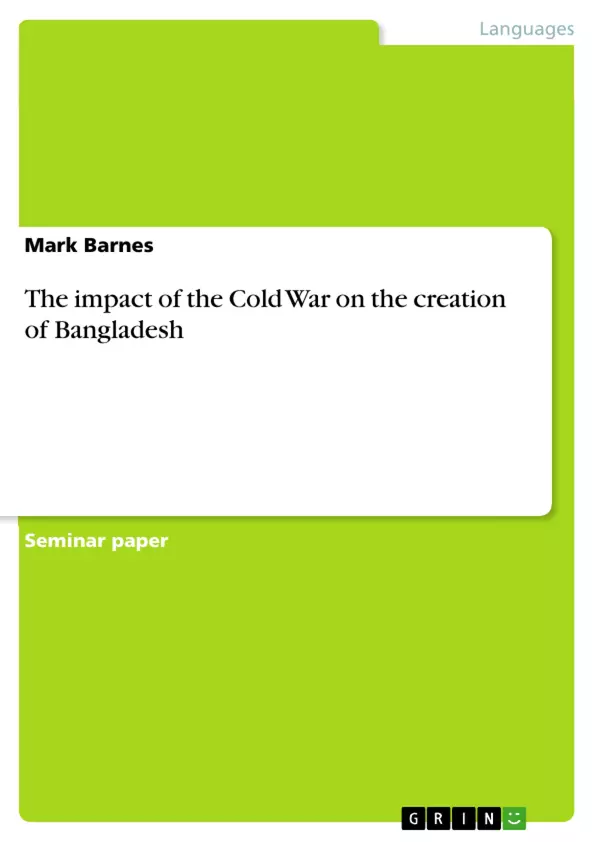This paper goes into the background covering the differences leading up to the breakup of Pakistan, the civil war that broke out when West Pakistani troops tried to subdue the East, the regional war that broke out when India intervened, and the Cold War context that it was a part of at the time.
Table of Contents
- Background
- Civil War
Objectives and Key Themes
This paper examines the multifaceted factors contributing to the creation of Bangladesh, focusing on the interplay of internal conflicts, external intervention, and the Cold War context. It analyzes the historical background of East-West Pakistan relations, the events leading up to the 1971 war, and the impact of India's intervention.
- The historical and political divisions between East and West Pakistan.
- The role of cultural, linguistic, and economic disparities in fueling conflict.
- The impact of the 1971 Civil War and the subsequent intervention of India.
- The influence of Cold War dynamics on the conflict.
- The human cost of the conflict, including widespread violence and displacement.
Chapter Summaries
Background: This section sets the stage for the creation of Bangladesh by outlining the significant differences between East and West Pakistan. It details the geographical separation, distinct languages (Bengali versus Urdu), cultural disparities, and the stark economic and political inequalities that fueled growing discontent among East Pakistanis. The disproportionate allocation of resources, with West Pakistan receiving significantly more funding despite East Pakistan's larger population, is highlighted as a major point of contention. The imposition of Urdu as the national language, despite the prevalence of Bengali in East Pakistan, further exacerbated existing tensions and ignited protests, underscoring the deep-seated cultural and linguistic divide that played a crucial role in shaping the future conflict. The chapter lays the groundwork for understanding the eventual eruption of the 1971 war by demonstrating the long-simmering resentment and the failure of the Pakistani government to address the fundamental grievances of the East Pakistani population.
Civil War: This chapter details the outbreak of the 1971 Civil War between East and West Pakistan. It describes the Pakistani military's Operation Searchlight, a brutal crackdown designed to quell Bengali demands for autonomy. The formation of the Mukti Bahini, the Bengali guerrilla force, and their unexpected resilience against the Pakistani army are discussed. The chapter also highlights the significant human cost of the war, including the mass killings, rapes (estimated between 200,000 and 400,000 women), and the displacement of millions of refugees into India. The targeting of specific groups, such as Hindus and intellectuals, reveals the systematic nature of the violence. The chapter emphasizes the Pakistan army's underestimation of Bengali resistance and the devastating consequences of their actions, laying the groundwork for India's subsequent intervention and the eventual creation of Bangladesh.
Keywords
Bangladesh, Pakistan, Cold War, Civil War, Mukti Bahini, Bengali, Urdu, Partition of India, political repression, economic inequality, refugee crisis, genocide, Operation Searchlight, India's intervention.
Frequently Asked Questions: A Comprehensive Language Preview of the Creation of Bangladesh
What is the purpose of this document?
This document provides a comprehensive overview of the creation of Bangladesh, including its historical background, key events, and significant themes. It serves as a preview, offering a structured analysis of the topic suitable for academic use.
What topics are covered in the document?
The document covers the historical and political divisions between East and West Pakistan, the role of cultural and economic disparities in fueling the conflict, the impact of the 1971 Civil War and India's intervention, the influence of Cold War dynamics, and the human cost of the conflict (including widespread violence and displacement).
What are the main chapters and their summaries?
The document is divided into chapters on "Background" and "Civil War." The "Background" chapter establishes the context by highlighting the significant differences between East and West Pakistan, including geographical separation, linguistic differences (Bengali versus Urdu), cultural disparities, and economic inequalities. It emphasizes the resentment caused by unequal resource allocation and the imposition of Urdu as the national language. The "Civil War" chapter details the outbreak of the 1971 war, the Pakistani military's brutal crackdown (Operation Searchlight), the formation and resilience of the Mukti Bahini, the immense human cost (including mass killings, rapes, and displacement), and the eventual Indian intervention.
What are the key themes explored in the document?
Key themes include the historical and political divisions between East and West Pakistan; the role of cultural, linguistic, and economic disparities in fueling conflict; the impact of the 1971 Civil War and India's intervention; the influence of Cold War dynamics on the conflict; and the human cost of the conflict, including widespread violence and displacement.
What keywords are associated with this document?
Keywords include Bangladesh, Pakistan, Cold War, Civil War, Mukti Bahini, Bengali, Urdu, Partition of India, political repression, economic inequality, refugee crisis, genocide, Operation Searchlight, and India's intervention.
What is the overall objective of this preview?
The objective is to provide a structured and professional overview of the creation of Bangladesh, highlighting the multifaceted factors that contributed to this significant historical event. It aims to analyze the themes in a way that is easily accessible and informative for academic purposes.
What type of audience is this document intended for?
This document is intended for academic use, facilitating the analysis of themes related to the creation of Bangladesh in a structured and professional manner.
Where can I find more information on this topic?
Further research can be conducted using the keywords provided in the document to explore various academic resources such as books, journals, and online archives related to the history of Bangladesh and the 1971 war.
- Citation du texte
- Mark Barnes (Auteur), 2015, The impact of the Cold War on the creation of Bangladesh, Munich, GRIN Verlag, https://www.grin.com/document/336248



